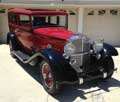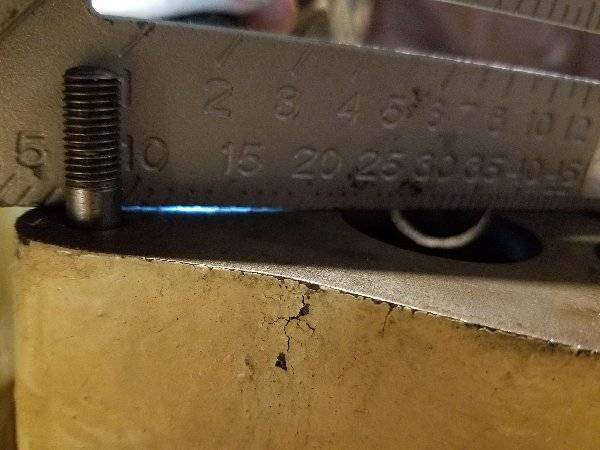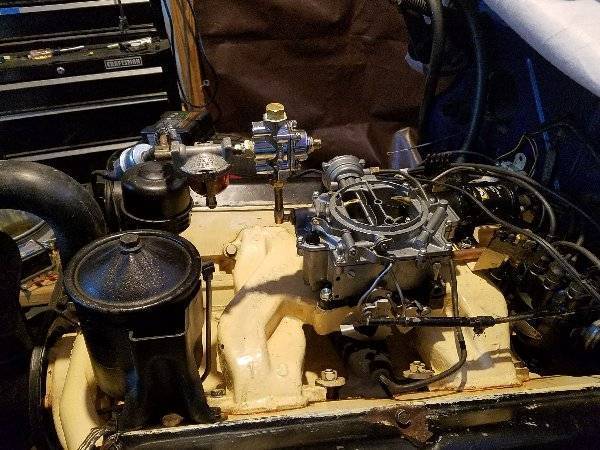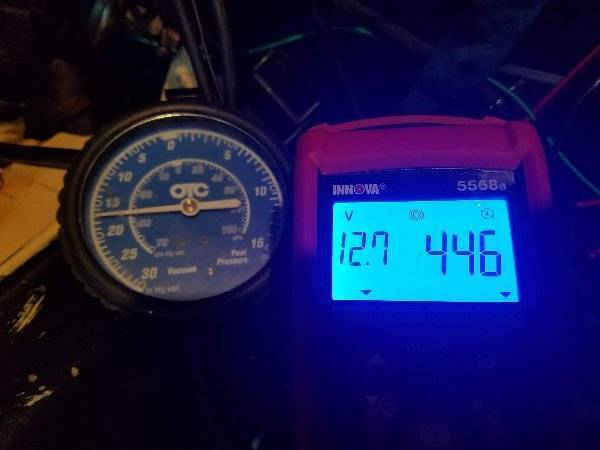|
Carb/Intake Gasket seal
|
||||
|---|---|---|---|---|
|
Home away from home
|
Hi,
Been fighting an idle and high rpm miss for a while (see project blog): packardinfo.com/xoops/html/modules/newbb ... lat&order=ASC&type=&mode=0&start=70 I've been trying everything to isolate with no luck. last week, I removed the intake manifold (with carb attached) and now that I reinstalled it, it runs even worse and won't idle below 700rpm. Very much a vacuum leak. Took some starter fluid and was spraying around the carb/manifold interface. When I squirted the driver side throttle shaft area, the rpm picked up. Due to the linkages, I can't tell if the rpm changed when the fluid hit the throttle shafts or the carb/manifold interface. Carb was rebuilt by Daytona so I am assuming they would have checked a need to re-sleeve the throttle shaft bores. I pulled the carb off and as you can see from the attached photo, there is no indent in the gasket from the manifold side on the driver side, but a noticeable one on the passenger side. This makes we want to believe this is the source of the vacuum leak. I checked the carb nuts torque several times so I know each 4 nuts were the same. Should I just crank harder on the driver side? Or is there some RTV type material I could use and trust? I'm hesitant to use anything that fuel may deteriorate and end up in the engine. I've had a miss since before I tore my engine apart, not sure this is related. Anyone have experience with these intake manifolds warping a little and need to be machined? I guess it could be the carb face could be the culprit too and bending when I torque down the nuts. thanks -Bob
Posted on: 2019/9/14 16:10
|
|||
|
Bob
1955 Packard Patrician Sapphire Blue |
||||
|
||||
|
Re: Carb/Intake Gasket seal
|
||||
|---|---|---|---|---|
|
Home away from home
|
Maybe check the flatness of the carb bottom surface and the manifold with a straight edge.
Posted on: 2019/9/14 18:14
|
|||
|
||||
|
Re: Carb/Intake Gasket seal
|
||||
|---|---|---|---|---|
|
Forum Ambassador

|
No idea if that's the source of your problem, but if you don't want to take the manifold to a machine shop, it looks like it would be a simple matter to just dress off that corner with a broad, flat file. And maybe use a gasoline-compatible gasket sealant.
Posted on: 2019/10/2 21:23
|
|||
|
||||
|
Re: Carb/Intake Gasket seal
|
||||
|---|---|---|---|---|
|
Home away from home

|
For a gasket solution on badly matching surfaces, read my post #27 on how I solved it on my 32 901 sedan.
Posted on: 2019/10/5 14:02
|
|||
|
||||
|
Re: Carb/Intake Gasket seal
|
||||
|---|---|---|---|---|
|
Home away from home
|
UPDATE:
I used the approach suggested by Dave and took a long file and dressed that corner. I was careful to always maintain corner to corner contact, which helped make it much flatter. When I started, the file didn't make any marks in the middle of the manifold. So I continued, swapping corners, until all of the manifold was lightly touched. Also, and this may be the bigger contributor, I switched gaskets. The gasket that came with it from Daytona was a relatively thin, compressed paper gasket. I replaced that with one that came in the engine rebuild kits that is a little thicker and more 'fibrous' In addition, I bought a fuel pressure regulator and dialed down the pressure from about 7psi to ~5 psi as per Daytona's strong insistence that this is the major problem. The first pic shows this plumbed in. No one else on this forum talks about this, so thinking that the Carquest/Airtex #6866 fuel pump (from the Parts X-Ref section) works but is too high in pressure to allow the engine to run smoothly. It is rated at 6psi-7.5psi. Anyone else have a similar issue?? End result is that the engine runs much more smoothly. I am able to get it to idle around ~450rpm. The noticeable, random miss (shudder) is still there but significantly reduced in magnitude. The picture shows the rpm along with vacuum gauge (connected to the carb rear vac source normally used for the check valve and connection to vacuum cylinder and brakes). ~17in vac seems low to me for a rebuilt engine. I adjusted the 2 idle mixture screws to maximize vacuum. Not sure what else to do so planning on putting the front clip back on and driving it for a while. Thanks again to all for the suggestions!!
Posted on: 2019/11/3 15:57
|
|||
|
Bob
1955 Packard Patrician Sapphire Blue |
||||
|
||||
|
Re: Carb/Intake Gasket seal
|
||||
|---|---|---|---|---|
|
Home away from home
|
Actually I believe I mentioned the fuel pressure regulator on my 1954 Patrician which, in combination with graphite oil (by Mobile, as I recall) made a major increase in fuel economy. I still have some new cans of the oil and the pressure regulator but not currently in the car. With the graphite oil alone, I had to crank down the idle since the engine was almost at road speed once it circulated throughout. Too bad it never caught on.
Posted on: 2019/11/3 16:08
|
|||
|
All generalities are false.
Once I thought I was wrong but I was mistaken. Don Pierson Packard / IMPERIAL page CA DMV Licensed Vehicle VIN Verification 1951 Henney-Packard 3-Door Long Wheelbase Air Force Ambulance The 1951 Henney-Packard is For Sale! 1954 Packard Patrician 1954 Packard Patrician Parts Car 1956 Clipper Custom Sedan |
||||
|
||||

 (388.60 KB)
(388.60 KB)










